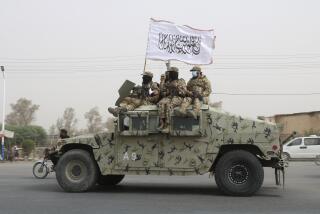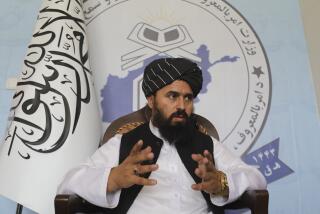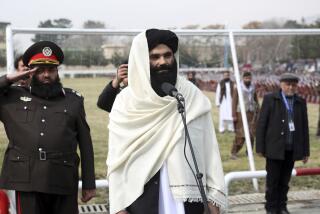Fundamentalists Vow to Seize All of Afghanistan
- Share via
AT THE SALANG TUNNEL, Afghanistan — At their front line in the rocky, wind-swept Hindu Kush mountains, Taliban militiamen vowed Wednesday to spread their doctrine of Islamic fundamentalism right up to the border of the former Soviet Union.
In a military blitzkrieg, the Talibs scored their most dazzling success with the capture of Kabul, the capital, six days ago. Having set to flight the government of President Burhanuddin Rabbani and imposed a harsh form of Islamic law there, they have moved north in pursuit of their adversaries, leaving many of Afghanistan’s neighbors jittery and worried that the strategic balance in Central Asia has shifted.
“We want to capture all of Afghanistan,” Mullah Lambat, the bearded 35-year-old commander of a detachment of 300 Talibs, said as he lounged with some of his fighters at a roadside inn commandeered to serve as a barracks along the southern edge of the strategic Salang tunnel, the highest tunnel in the world.
Lambat’s weather-beaten, turbaned fighters seemed well supplied with Soviet-made assault rifles, rocket-propelled-grenade launchers, four-wheel-drive vehicles and walkie-talkies.
Barefoot, they reclined on a raised wooden platform set against the inn’s whitewashed concrete walls, waiting for a lunch of rice to be doled out from a large tin pot set on the steps outside.
They appeared fit, hearty and confident of eventual victory.
“Everywhere we have come, people have helped us,” said Mullah Noorhasson, a Taliban cleric. “And when the people help us, there is no one who can fight us.”
North from Kabul, along a road littered with dozens of abandoned Soviet-made tanks and other military vehicles, the wreckage of 17 years of uninterrupted warfare in Afghanistan, other Talibs riding in the back of pickup trucks moved throughout the day, evidently bound for the front.
Lambat’s fighters predicted that battle would be joined with the remnants of the ousted government’s forces before the onset of winter.
Those forces, led by Rabbani’s military chief, Ahmed Shah Masoud, retreated into the Panjsher valley after their army disintegrated during the Taliban advance on Kabul. But Masoud still has as many as 10,000 of his 15,000 to 20,000 fighters. In the Panjsher, he is on home ground, said one relief agency official in Kabul, who receives regular updates on the military situation from workers in the field.
As for the Talibs’ other remaining adversary, the northern warlord Abdul Rashid Dostum, whose six-province fiefdom borders the former Soviet republics of Uzbekistan, Tajikistan and Turkmenistan, he will also be neutralized--through negotiations or on the battlefield--the Taliban fighters said.
“If Rashid Dostum lets us, we will start Islamic religious practices in his provinces,” said the leather-skinned Lambat, a Pathan from southern Afghanistan. “If he doesn’t, we will capture these provinces by force of arms.”
Dostum, a leader of legendary ruthlessness, has an estimated 30,000 men. The Talibs may have 50,000, according to admittedly sketchy U.N. estimates, but they are spread throughout the country.
Three days ago, Lambat’s detachment occupied positions on the commanding heights three miles south of the Salang tunnel, a 1.6-mile passage that pierces the barren, sheer-sided peaks of the Hindu Kush and carries Afghanistan’s major north-south road into Dostum’s territory.
Up the road, at a barren site called Posti Ziarat 60 miles north of Kabul, a small group of Talibs stood guard near the southern approach to the tunnel. A truck of watermelons, and buses carrying civilian passengers south from the warlord’s territory were checked by the Talibs and allowed to continue toward the capital.
Lambat and his men said they were waiting for orders from supreme Taliban commanders on whether to attack Dostum, who moved fighters to the southern entrance of the Salang tunnel last weekend to block the Talibs’ progress northward.
The arrival of the Talibs on the other side of the Amu Darya river from the territory of the former Soviet Union would be a major worry for Moscow and its allies in Central Asia.
In 1979, the Soviet Union invaded Afghanistan, largely out of concern that Islamic militancy might spread from this country to the mostly Muslim populations of Moscow’s Central Asian republics.
“We don’t believe in our guns. We believe in God,” said Amir Khan Mohtaki, one of Lambat’s senior fighters, on Wednesday.
With the Taliban now claiming to control three-quarters of Afghanistan, and announcing the creation of a provisional government to secure international recognition, Moscow’s old fears seem more plausible than ever.
Russian President Boris N. Yeltsin has called a summit of the former Soviet republics to assess the implications of the Taliban’s success.
Though an Islamic fundamentalist state itself, neighboring Iran, which backed a Shiite faction in western Afghanistan that was defeated earlier by the Taliban, is also known to be very uneasy over the rapid advances of the predominantly Sunni force.
The relief agency official in Kabul predicted still more fighting.
“One thing that the history of Afghanistan shows is that every group is vulnerable,” the official said.
(BEGIN TEXT OF INFOBOX / INFOGRAPHIC)
Forces Headed North
Taliban militia vowed Wednesday to spread its doctrine of Islamic fundamentalism right up to the border of the former Soviet Union. Afghan forces from all sides are now gearing up for a possible confrontation along the 300-mile Salang highway, which connects the capital to northern Afghanistan and beyond.
1. Ousted government troops
2. Forces of warlord Abdul Rashid Dostum
More to Read
Sign up for Essential California
The most important California stories and recommendations in your inbox every morning.
You may occasionally receive promotional content from the Los Angeles Times.










